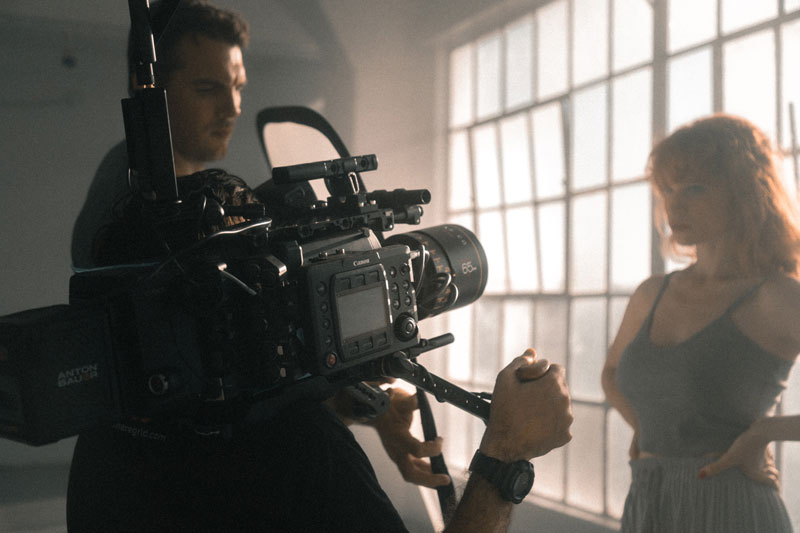
14 Oct Filmmaking 101: Working With Talent
Continuing on our series on mise-en-scéne, a central part of any production is working with talent.
When most people hear the word talent they automatically think actors. Big Hollywood stars! And, they’d be right. But talent can also apply to non-narrative productions. It can be anything from a brand ambassador, to a guest speaker, a field expert, or if you’re making your own productions, it can even be you!
In this post we’ll explore the elements that make up a performance, performance style and arranging talent in front of the camera. All of which are important considerations for any type of production as they have a great impact on how the audience perceives the productions and how your message is conveyed.
Elements of Performance
Whether you’re working with talent in a narrative film, a documentary, a Twitch stream, an explainer video or whatever it may be: if someone’s talking or in front of the camera, they’re giving a performance.
That means their voice, physical expressions and gestures are helping to represent the message of your production to the audience. The two major elements that make up a performance are:
1. Voice
– Language
– Timbre
– Accent
– Intonation
In a narrative production, voice can highlight features of a character and provide subtle insights that support the story. Voice is equally important in non-narrative productions, particularly for podcasts, advertisements or animations where it carries the message entirely or needs to support the visuals in an appropriate manner.
Remember, you can be working with the wrong talent too. Find the right voice to sell the message (for instance you can’t sell Australia with an American accent).
Paul Hogan provides a prime example using accent and language to convey the right message to the right audience.
2. Bodily Movement
– Hand and Body Gestures
– Facial Expressions
– Eye Contact
Bodily movements and gestures support the vocal element of performance and are intrinsically linked. Voice actors will even make bodily movements whilst recording to get an authentic performance.
Non-narrative productions like explainer videos rely heavily on bodily movement as well.
When working with talent on an explainer video for instance, those talking directly to the camera, it’s important for your talent to maintain eye contact and use hand gestures to give the message more conviction and authority.
Performance Styles
The combination of performance elements makes up your performance style and there are two main performance styles:
Stylised – This is an elevated and self-aware style of performance, where it is obvious that the subject is performing. Though this style has diminished in narrative productions it has made a resurgence in online content like Twitch streaming and gaming videos, where creators will create an over the top character for comedic effect and a point of difference. Ozzy Man Reviews is a great example of a stylised performance.
Naturalistic – As the name suggests this is a more natural performance style which is popular in narrative productions because it creates a more immersive and authentic experience. It can also be incredibly useful for instructional and educational videos to again give your image and message more gravitas.
Blocking
Blocking is the dramatic term used to describe the placement and movement of talent in the performance space. Blocking is important for creating patterns that appeal to the eye and effective conveying meaning and messages.
The two main styles of blocking are:
Social – Arranging talent in a way that creates a sense of relationship between subjects in the scene. This can be used to convey tension, affection or a whole range of emotions in a really subtle way. It’s particularly useful in character driven production as well as advertising, where you want the audience to intuitively pick up on a feeling or emotion very quickly.
Graphic – This blocking style is used to create patterns and draw the eye to a particular point in the frame. It’s particularly useful if you want to play with a depth of field or you want to centralise all focus on one particular element. In an explainer video for instance you want the audience to focus on you and what you’re trying to tell them which is why you would often be positioned in the centre of the frame.
Check out this awesome video from StudioBinder about blocking techniques and the patterns they create to draw attention and convey meaning.
Working With Actors
When just starting out we won’t be able to work with big name movie stars (not yet at least!). In fact, in the beginning you might have to pull in favours from all sorts of people in your extended network who might not necessarily be actors. Bringing people to help you complete your masterpiece can be challenging and it exposes you to a wide variety of personalities, some easy and some difficult.
This can lead to some tense situations and disagreements, particularly if you have a very clear vision for your work. As a general rule in directing actors it’s of course important to treat everyone with respect, to be professional and assertive but also open and collaborative.
Particularly if working with professional actors, involve them in your production process, they are creatives as well and may offer you some great insight that you hadn’t considered.
Here’s a fantastic video from Film Riot on how to work with new actors who are inexperienced. Enjoy!


